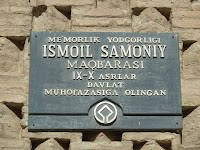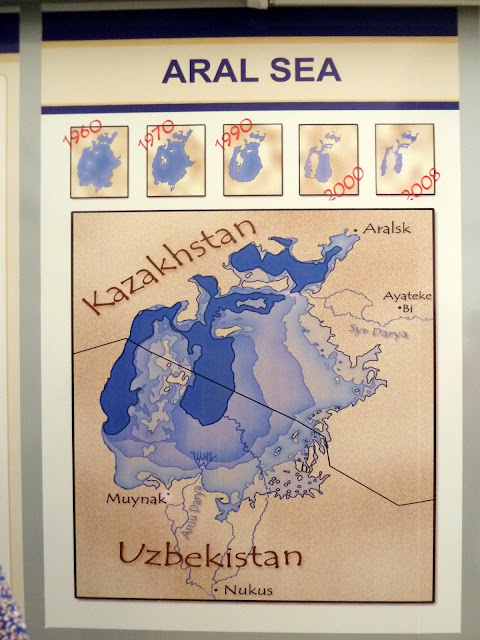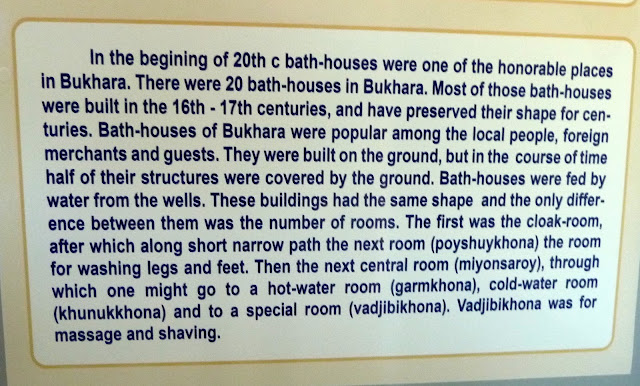I
had been to Tashkent in 1983 and my lasting memory of it was they sold awesome sweet
melons! I had brought back 16 of them, as instructed by my wife, and she had
thoroughly enjoyed each one of them. Of the city, I recalled nothing so we went
with a totally fresh look. As always, I like to spend a minimum of three full
days, packed with sightseeing, so we cover all the most important sights
and events. In separate blogs, I have written about our excursion to the Chimgan
Mts and Charvak reservoir - a Tashkent day trip; A magical evening with the
Alisher Navoyi Opera; the Museum of Art - a unique private public gem; and Uzbek
weddings - taking a peek into a modern trend. Do read them. So this blog is on
the city itself.


We were staying at Hotel Uzbekistan – a massive Soviet style hotel with a zillion rooms!! The service was the pits, the room quality was equally bad but we had no choice as that’s where the group was staying!! But the food was really good in the restaurants. Now, in case you did not know, the currency exchange was different from the regular Govt rate.... which changed by the time we returned to Tashkent for Part 2 of our stay!! So here you have our tour leader giving me a large bucketful of local currency for a few dollars. On 5th September 2017, it all changed to half the amount. The touts and bellboys were out of business as the hotel officially opened an exchange counter in the hotel.... which had never happened before.


 The
name Tashkent is derived from the Turkish word "tash" (stone) and the
Persian word "kent" (city), meaning "city of stones". Some say
the Sogdian word "tschatsch", meaning "place on a hill". Tashkent is the capital and the most cosmopolitan
city in Uzbekistan. It is known for its tree-lined streets, numerous fountains,
and pleasant parks. Since 1991, the city has changed economically,
culturally, and architecturally.
The
name Tashkent is derived from the Turkish word "tash" (stone) and the
Persian word "kent" (city), meaning "city of stones". Some say
the Sogdian word "tschatsch", meaning "place on a hill". Tashkent is the capital and the most cosmopolitan
city in Uzbekistan. It is known for its tree-lined streets, numerous fountains,
and pleasant parks. Since 1991, the city has changed economically,
culturally, and architecturally.
New development has superseded or replaced
icons of the Soviet era. The largest statue ever erected for Lenin was replaced
with a globe, featuring a geographic map of Uzbekistan. Buildings from the
Soviet era have been replaced with new modern buildings. The "Downtown
Tashkent" district includes the 22-story NBU Bank building, an Intercontinental Hotel, the International
Business Centre, and the Plaza Building. The Tashkent Business district is a
special district, established for the development of small, medium and large
businesses in Uzbekistan. In 2007, Tashkent was named a "cultural capital
of the Islamic world" by Moscow News,
as the city has numerous historic mosques and significant Islamic sites, including
the Islamic University.
Due
to the destruction of most of the ancient city during the 1917 revolution and, later
1966 earthquake, little remains of Tashkent's traditional architectural
heritage. Tashkent is, however, rich in museums and Soviet-era monuments.
 This is a one-storey private residence of Nikolai
Konstantinovich Romanov, who was a grandson of Emperor Nikolai I, and who was
exiled by his royal parents to Tashkent in 1877 to live there until his death
in 1918.The Prince Romanov’s residence was built in "modern" style.
The elegant building was richly decorated with carved grids, unusually shaped
windows, towers and other decorative elements. The duke was a keen hunter and
the front entrance to the private residence was decorated with bronze figures
of deer and hunting dogs. There was a large garden laid out by the famous
Tashkent botanist and pharmacist I.I. Krause. Particular attention was given to
the interior design of the palace. The halls of the private residence were
lined with dark oak, decorated with carved cornices and golden paintings. From
the main hall, the three doors led to the apartments of the prince and his
wife. The residence housed a billiard room, library, dining room and a Japanese
garden. The Prince was extremely popular in the local community. He opened the
first cinema theatre in the city and a bakery, built a ducal soldiers’ suburb
in the city’s centre, laid irrigation canals in the Golodny Steppe. During the
years spent in Tashkent, he amassed a unique collection of antiques and books,
later bequeathed to the city. After his death, the building housed the Museum
of Art’s of Uzbekistan, then Museum of Antiques and Jewellery of Uzbekistan,
and in Soviet times it was used for the Palace of the Pioneers. At the end of
the XX century, the building was restored and is now used as the Reception House
of the MFA of Uzbekistan.
This is a one-storey private residence of Nikolai
Konstantinovich Romanov, who was a grandson of Emperor Nikolai I, and who was
exiled by his royal parents to Tashkent in 1877 to live there until his death
in 1918.The Prince Romanov’s residence was built in "modern" style.
The elegant building was richly decorated with carved grids, unusually shaped
windows, towers and other decorative elements. The duke was a keen hunter and
the front entrance to the private residence was decorated with bronze figures
of deer and hunting dogs. There was a large garden laid out by the famous
Tashkent botanist and pharmacist I.I. Krause. Particular attention was given to
the interior design of the palace. The halls of the private residence were
lined with dark oak, decorated with carved cornices and golden paintings. From
the main hall, the three doors led to the apartments of the prince and his
wife. The residence housed a billiard room, library, dining room and a Japanese
garden. The Prince was extremely popular in the local community. He opened the
first cinema theatre in the city and a bakery, built a ducal soldiers’ suburb
in the city’s centre, laid irrigation canals in the Golodny Steppe. During the
years spent in Tashkent, he amassed a unique collection of antiques and books,
later bequeathed to the city. After his death, the building housed the Museum
of Art’s of Uzbekistan, then Museum of Antiques and Jewellery of Uzbekistan,
and in Soviet times it was used for the Palace of the Pioneers. At the end of
the XX century, the building was restored and is now used as the Reception House
of the MFA of Uzbekistan. Our
group walked down from the hotel straight to the park with the large statue of Emir
Timur. Then further south, we came across a vendor renting cycles. There was a
large art alley with artists painting and lots of artworks on sale. Very few
buyers. On our way to a fine dining restaurant on our
last evening, we came across this round monument. I can’t recall what it is but
I did like its design and style.
Our
group walked down from the hotel straight to the park with the large statue of Emir
Timur. Then further south, we came across a vendor renting cycles. There was a
large art alley with artists painting and lots of artworks on sale. Very few
buyers. On our way to a fine dining restaurant on our
last evening, we came across this round monument. I can’t recall what it is but
I did like its design and style.
Independence Square has the most beautiful
fountains of the city. Upon declaration of independence in 1991, Lenin Square
was re-named Independence Square (Mustakillik Maydoni) in 1992. The monument to
Lenin was dismantled and an Independence Monument in a form of a globe with
Uzbekistan’s borders outlined on it was installed instead. Many buildings were
renovated and acquired a modern look. The central figure of the square is
sixteen marble columns joined by a bridge, supporting the sculptures of storks
who symbolize peace and quietness. The alleys with green zones and beautiful
fountains from both sides stretch from the colonnade to the Independence
Monument. Under the monument there is a figure of a woman holding a baby in her
arms – a symbol of Mother-Motherland.
Telyashayakh
Mosque or Khast Imam Mosque is beautiful. Like other mosques, you have to walk
a lot inside to get to your destination! It contains the Uthman Qur'an, considered to be the oldest Koran in the world. No photos allowed but they
permitted me to photograph the caption there. Dating from 655 and stained with
the blood of murdered caliph, Uthman, it was brought by Timur to Samarkand, seized by the Russians as a war trophy and taken to
St Petersburg and only returned to Uzbekistan in 1924.
The
State Museum of Uzbekistan – we landed up not knowing that we would be in the
middle of a major exhibit inauguration! We decided on taking an English
speaking guide who was excellent. Halfway through, she made us go downstairs as
the Director was going to inaugurate an art exhibit of a leading artist. I met
her and the singer who had a voice like a nightingale!! She invited me to her performance but my
family weren’t keen on going !!
 This
is an outstanding modern museum with excellent captions. There are five floors
full of fabulous artworks... not only paintings... you have carved wood, suzani hangings, textiles, a major collection of art from the pre-Russian
period, including Sogdian murals, Buddhist statues and Zoroastrian art, along with a more modern
collection of 19th and 20th century applied art. There is the large collection of paintings
"borrowed" from the Hermitage by Grand Duke Romanov to decorate his
palace in exile in Tashkent, and never returned. Do not miss this museum if you
are in Tashkent.
This
is an outstanding modern museum with excellent captions. There are five floors
full of fabulous artworks... not only paintings... you have carved wood, suzani hangings, textiles, a major collection of art from the pre-Russian
period, including Sogdian murals, Buddhist statues and Zoroastrian art, along with a more modern
collection of 19th and 20th century applied art. There is the large collection of paintings
"borrowed" from the Hermitage by Grand Duke Romanov to decorate his
palace in exile in Tashkent, and never returned. Do not miss this museum if you
are in Tashkent. 


Tashkent
cafes and restaurants have Uzbek as well as European, Middle Eastern and
Russian cuisines. Old part of the city is the centre of traditional local
cuisine in Tashkent. Between Kukeldash Madrassah and Chorsu bazaar you find a
great number of chaykhanas (café terrace with ayvans), cafes and eating houses,
where you can snack a kebab, shaurma, Uzbek somsa and etc. Also you can try
national dishes in family-run Uzbek houses. Close to the Yunus-Obod tennis
court there is the huge Pilaf centre (Osh Markazi), where you taste delicious
wedding Tashkent pilaf. You will be surprised with wide range of restaurants
with Chinese, Italian, English, Japanese, Spanish, Korean and other cuisine.

There
are two parts to the city – the new and the old. Both are interesting and can
occupy your time quite happily. I love the city especially as one can walk
quite safely in both parts, with necessary common sense, as always.
Text and photographs copyright of the author. No part of this article or photographs maybe transmitted or reproduced by any means, electronic, mechanical, photocopying or otherwise, without written permission. Do contact the author on email -- helpthesun@gmail.com













































































